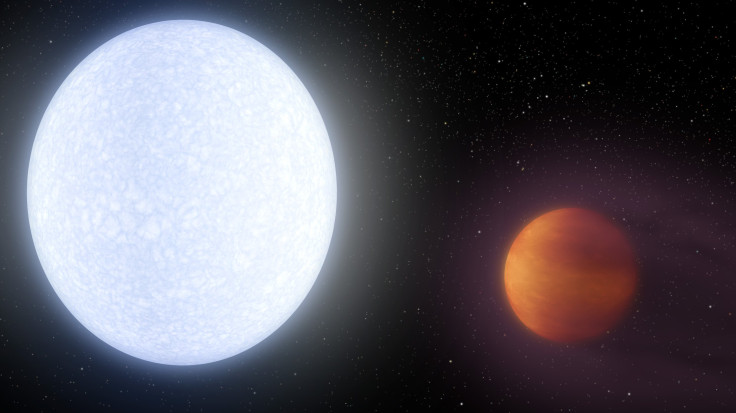A Planet Hotter Than Most Stars? Jupiter-Like Exoplanet KELT-9b May Be Just That

The sun is the largest energy source for Earth, and its surface temperature of about 10,000 degrees Fahrenheit (5,500 degrees Celsius) is far hotter than the hottest places on Earth, or even Venus — the hottest planet in the solar system — where surface temperatures can go up to 882 degrees Fahrenheit. In general, stars, which are luminous spheres made up of plasma, are much hotter than planets.
Which is why astronomers are somewhat surprised to have found a planet that has surface temperatures higher than most stars. A Jupiter-like exoplanet, which has been named KELT-9b, lies about 650 light-years away from Earth in the Cygnus constellation and orbits the massive star KELT-9. The planet’s side that faces its host star records temperatures up to over 7,800 degrees Fahrenheit. The planet, which orbits its star every one-and-a-half days, is so hot that it even has a huge glowing tail, like a comet.
Read: KELT-11b Is A ‘Styrofoam’ Planet With Low Mass, Large Size
Researchers led by astronomers from Ohio State University and Vanderbilt University in Nashville, Tennessee, are publishing a paper this week in the journal Nature which explains why the planet could reach temperatures over three-fourths the sun’s surface. They theorize that the star-facing side of the KELT-9b is lashed by ultraviolet radiation, and the fact that the planet is tidally locked to its star — the same side always faces the star, like the moon and Earth — the bombardment of stellar radiation is constant.
The massive star it orbits, KELT-9, is about twice as large and twice as hot as the sun. The exoplanet’s orbit is also very close to the star, and both these factors combine to explain the scorching temperatures on its surface.
“KELT-9 radiates so much ultraviolet radiation that it may completely evaporate the planet. Or, if gas giant planets like KELT-9b possess solid rocky cores as some theories suggest, the planet may be boiled down to a barren rock, like Mercury,” Keivan Stassun from Vanderbilt, who was one of the lead authors of the study, said in a statement Monday. “KELT-9 will swell to become a red giant star in about a billion years. The long-term prospects for life, or real estate for that matter, on KELT-9b are not looking good.”
The superheating leads to other unusual properties for the planet as well, such as the comet-like glowing gas tail. It could be produced as the planet gets literally evaporated by the intense heat from its star. KELT-9b is 2.6 times more massive than our solar system’s largest planet. However, its density is only half of Jupiter’s, because extreme radiation from KELT-9 has massively bloated the exoplanet’s atmosphere. The heat also means molecules like water, carbon dioxide or methane can never form there.
Read: KELT Finds Planet In Rare Triple Star System
“It’s a planet by any of the typical definitions based on mass, but its atmosphere is almost certainly unlike any other planet we’ve ever seen just because of the temperature of its day side,” Scott Gaudi, professor of astronomy at Ohio State University who directed the study with Stassun, said in the statement.
KELT-9b was discovered as it transited across the face of its host star. It was first spotted in 2014, using the Kilodegree Extremely Little Telescopes, which is where the name KELT comes from. It is part of the category of planets that are labeled “hot Jupiter.”
The paper, titled “A giant planet undergoing extreme-ultraviolet irradiation by its hot massive-star host,” will also be presented at the spring meeting of American Astronomical Society in Austin, Texas, being held from June 4-8.
© Copyright IBTimes 2024. All rights reserved.





















